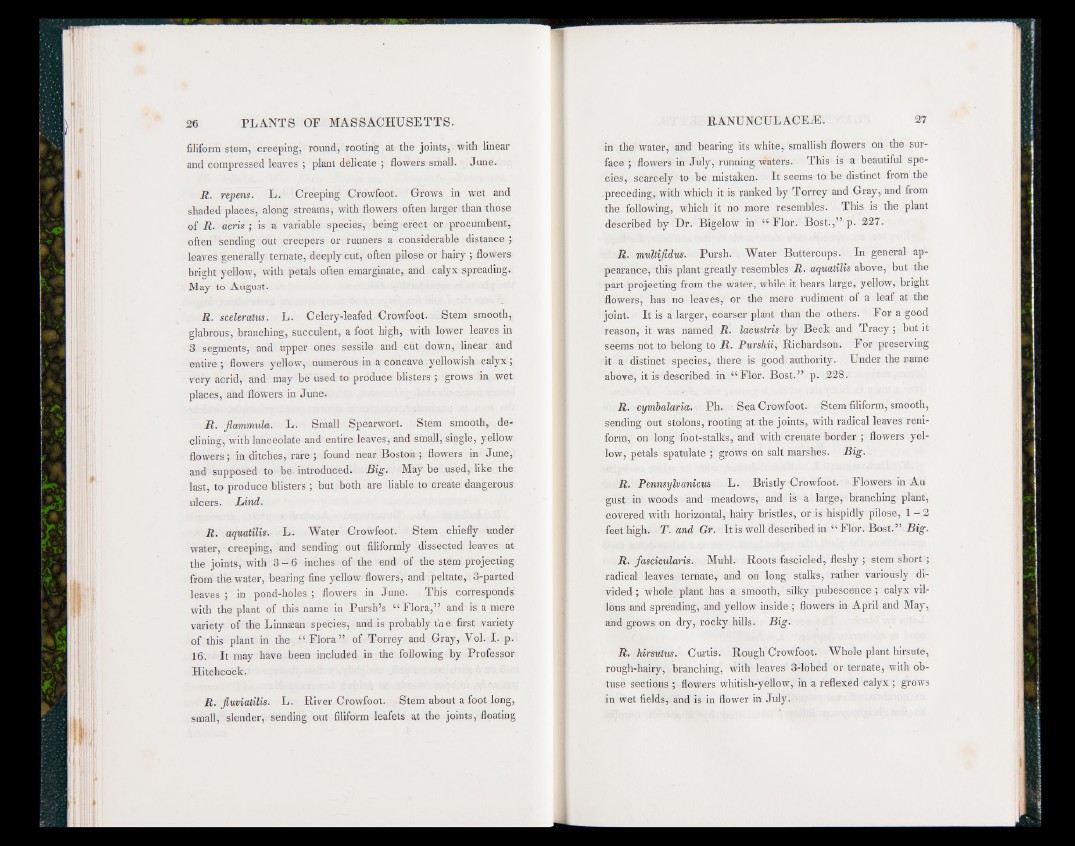
filiform stem, creeping, round, rooting at the joints, with linear
and compressed leaves ; plant delicate ; flowers small. June.
R. repens. L. Creeping Crowfoot. Grows in wet and
shaded places, along streams, with flowers often larger than those
of R. acris; is a variable species, being erect or procumbent,
often sending out creepers or runners a considerable distance ;
leaves generally ternate, deeply cut, often pilose or hairy ; flowers
bright yellow, with petals often emarginate, and calyx spreading.
May to August.
R. sceleratus. L. Celery-leafed Crowfoot. Stem smooth,
glabrous, branching, succulent, a foot high, with lower leaves in
3 segments, and upper ones sessile and cut down, linear and
entire; flowers yellow, numerous in a concave yellowish calyx;
very acrid, and may be used to produce blisters ; grows in wet
places, and flowers in June.
R . flammula. L. Small Spearwort. Stem smooth, declining,
with lanceolate and entire leaves, and small, single, yellow
flowers; in ditches, rare ; found near Boston ; flowers in June,
and supposed to be introduced. Big. Maybe used, like the
last, to produce blisters ; hut both are liable to create dangerous
ulcers. Bind.
R. aquatilis. L. Water Crowfoot. Stem chiefly under
water,' creeping, and sending out filiformly dissected leaves at
the joints, with 3 - 6 inches of the end of the stem projecting
from the water, hearing fine yellow flowers, and peltate, 3-parted
leaves ; in pond-holes ; flowers in June. This corresponds
with the plant of this name in Pursh’s C£ Flora,” and is a mere
variety of the Linnaean species, and is probably t’ne first variety
of this plant in the “ Flora” of Torrey and Gray, Vol. I. p.
16. It may have been included in the following by Professor
Hitchcock.
R. Jluviatilis. L. River Crowfoot. Stem about a foot long,
small, slender, sending out filiform leafets at the joints, floating
in the water, and bearing its white, smallish flowers on the surface
; flowers in July, running waters. This is a beautiful species,
scarcely to be mistaken. It seems to be distinct from the
.preceding, with which it is ranked by Torrey and Gray, and from
the following, which it no more resembles. This is the plant
described by Dr. Bigelow in “ Flor. Bost.,” p. 227.
R. multijidus. Pursh. Water Buttercups. In general appearance,
this plant greatly resembles R. aquatilis above, but the
part projecting from the water, while it bears large, yellow, bright
flowers, has no leaves, or the mere rudiment of a leaf at the
joint. It is a larger, coarser plant than the others. For a good
reason, it was named R. lacustris by Beck and T ra cy ; but it
seems not to belong to R . Purshii, Richardson. For preserving
it a distinct species, there is good authority. Under the name
above, it is described in “ Flor. Bost.” p. 228.
R. cymbalaria. Ph. Sea Crowfoot. Stem filiform, smooth,
sending out stolons, rooting at the joints, with radical leaves reni-
form, on long foot-stalks, and with crenate border ; flowers yellow,
petals spatulate ; grows on salt marshes. Big.
R. Pennsylvanicus L. Bristly Crowfoot. Flowers in Au
gust in woods and meadows, and is a large, branching plant,
covered with horizontal, hairy bristles, or is hispidly pilose, 1—2
feet high. T. and Gr. It is well described in “ Flor. Bost.” Big-.
R. fascicularis. Muhl. Roots fascicled, fleshy ; stem short ;
radical leaves ternate, and on long stalks, rather variously divided
; whole plant has a smooth, silky pubescence ; calyx villous
and spreading, and yellow inside ; flowers in April and May,
and grows on dry, rocky hills. Big.
R. hirsutus. Curtis. Rough Crowfoot. Whole plant hirsute,
rough-hairy, branching, with leaves 3-lobed or ternate, with obtuse
sections ; flowers whitish-yellow, in a reflexed calyx ; grows
in wet fields, and is in flower in July. |